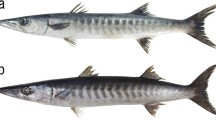Abstract
Encrasicholina integra sp. nov. is described from 10 specimens collected in Manokwari, West Papua, Indonesia. The new species is most similar to Encrasicholina oligobranchus (Wongratana 1983), which is redescribed, in sharing a short upper jaw with the posterior tip just reaching to the preopercle anterior margin, the dorsal and anal fins with three unbranched rays, a bony urohyal without fleshy knobs, and similar numbers of gill rakers. However, the former is characterized by a shorter head (its length 25.9–27.2% SL vs. 28.3–29.8% in E. oligobranchus), maxilla (its length 17.1–18.3% SL vs. 19.0–20.7%), and mandible (its length 17.5–18.7% SL vs. 19.1–20.5%), in addition to a deeper body (its depth 15.1–16.4% SL vs. 13.3–15.3%) and longer pelvic fin (9.3–10.2% SL vs. 8.7–9.4%).




Similar content being viewed by others
References
Chen C-H (2003) Fishes of Penghu. Fisheries Research Institute, Council of Agriculture, Keelung
Cuvier G (1816) Le Règne Animal, distribué d’après son organisation, pour servir de base à l’histoire naturelle des animaux et d’introduction à l’anatomie comparée. Les reptiles, les poissons, les mollusques et les annélides. Edition 1, vol 2. Chez Déterville, Paris
Fowler HW (1900) Contributions to the ichthyology of the tropical Pacific. Proc Acad Nat Sci Philadelphia 52:493–528
Fowler HW (1911) Notes on clupeoid fishes. Proc Acad Nat Sci Philadelphia 63:204–221
Fowler HW (1938) The fishes of the George Venderbilt South Pacific Expedition, 1937. Monogr Acad Nat Sci Philadelphia 2:i–v + 1–349, pls 1–12
Günther A (1868) Catalogue of the fishes in the British Museum. Vol. 7. Catalogue of the Physostomi, containing the families Heteropygii, Cyprinidae, Gonorhynchidae, Hyodontidae, Osteoglossidae, Clupeidae, Chirocentridae, Alepocephalidae, Notopteridae, Halosauridae, in the collection of the British Museum. British Museum, London
Hardenberg JDF (1933) Notes on some genera of the Engraulidae. Natuurk Tijdschr Ned-Ind 93:230–256
Hata H, Motomura H (2015) A new species of anchovy, Encrasicholina macrocephala (Clupeiformes: Engraulidae), from the northwestern Indian Ocean. Zootaxa 3941:117–124
Hata H, Motomura H (2016a) Two new species of the genus Encrasicholina (Clupeiformes: Engraulidae): E. intermedia from the western Indian Ocean and E. gloria from the Persian Gulf, Red Sea and Mediterranean. Raffles Bull Zool 64:79–88
Hata H, Motomura H (2016b) Validity of Encrasicholina pseudoheteroloba (Hardenberg 1933) and redescription of Encrasicholina heteroloba (Rüppell 1837), a senior synonym of Encrasicholina devisi (Whitley 1940) (Clupeiformes: Engraulidae). Ichthyol Res. https://doi.org/10.1007/s10228-016-0529-4 (also appeared in Ichthyol Res 64:18–28)
Hata H, Motomura H (2017) A new species of anchovy, Encrasicholina auster (Clupeiformes: Engraulidae) from Fiji, southwestern Pacific Ocean. N Z J Zool. https://doi.org/10.1080/03014223.2016.1268177 (also appeared in N Z J Zool 44:122–128)
Hata H, Motomura H (2020) A new species of anchovy, Encrasicholina sigma (Teleostei: Clupeiformes: Engraulidae) from Sulawesi, Indonesia. Zootaxa 4750:261–268
Lacepède BGE (1803) Histoire naturelle des poissons. Vol. 5. Chez Plassan, Paris
Lavoué S, Bertrand JAM, Wang H-Y, Chen W-J, Ho H-C, Motomura H, Hata H, Sado T, Miya M (2017) Molecular systematics of the anchovy genus Encrasicholina in the Northwest Pacific. PLoS ONE 12 (7): e0181329. https://doi.org/10.1371/journal.pone.0181329
Roberts TR (1984) Amazonsprattus scintilla, new genus and species from the Rio Negro, Brazil, the smallest known clupeomorph fish. Proc Calif Acad Sci (Ser 4) 43:317–321
Rüppell WPES (1837) Neue wirbelthiere zu der fauna von Abyssinien gehörig. Siegmund Schmerber, Frankfurt am Main
Sabaj MH (2019) Standard symbolic codes for institutional resource collections in herpetology and ichthyology: an online reference. Version 7.1. American Society of Ichthyologists and Herpetologists, Washington, DC. http://www.asih.org/. Accessed 4 Mar. 2020
Tiews K, Ronquillo IA, Santos LM (1970) On the biology of anchovies (Stolephorus Lacépède) in Philippine waters. Philipp J Fish 9:92–123
Whitehead PJP, Nelson GJ, Wongratana T (1988) FAO Fisheries Synopsis No. 125, Volume 7, Part 2. FAO species catalogue. Vol. 7. Clupeoid fishes of the world (suborder Clupeoidei). An annotated and illustrated catalogue of the herrings, sardines, pilchards, sprats, shads, anchovies and wolf-herrings. Part 2 – Engraulididae. FAO, Rome
Wongratana T (1983) Diagnoses of 24 new species and proposal of a new name for a species of Indo-Pacific clupeoid fishes. Jpn J Ichthyol 29:385–407
Wongratana T (1987) Four new species of clupeoid fishes (Clupeidae and Engraulidae) from Australian waters. Proc Biol Soc Washington 100:104–111
Wongratana T, Munroe TA, Nizinski MS (1999) Order Clupeiformes. Engraulidae. Anchovies. In: Carpenter KE Niem VH (eds) FAO species identification guide for fishery purposes. The living marine resources of the western central Pacific, vol 3. Batoid fishes, chimaeras and bony fishes Part 1 (Elopidae to Linophrynidae), FAO, Rome, pp 1698–1753
Acknowledgements
We thank O. Crimmen, J. Maclaine, and D. Nicholson (BMNH), D. Catania (CAS), Y. Kai (FAKU), G. Shinohara and M. Nakae (NSMT), and J. Williams, K. Murphy, S. Raredon, and D. Pitassy (USNM) for opportunities to examine specimens of Encrasicholina. We also thank G. Hardy (Ngunguru, New Zealand), for checking an early version of the manuscript. This study was supported in part by a Grant-in-Aid from the Japan Society for the Promotion of Science for JSPS Fellows (DC2: 29-6652); the Sasakawa Scientific Research Grant from the Japan Science Society (28-745); JSPS KAKENHI Grant Numbers 19K236910001, JP23580259, JP26450265, and JP20H03311; the JSPS Core-to-Core Program: B Asia-Africa Science Platforms; the “Biological Properties of Biodiversity Hotspots in Japan” project of the National Museum of Nature and Science, Tsukuba, Japan; and “Establishment of Glocal Research and Education Network in the Amami Islands” project of Kagoshima University adopted by the Ministry of Education, Culture, Sports, Science and Technology, Japan.
Author information
Authors and Affiliations
Corresponding author
Additional information
Publisher's Note
Springer Nature remains neutral with regard to jurisdictional claims in published maps and institutional affiliations.
This article was registered in the Official Register of Zoological Nomenclature (ZooBank) as 263D1517-60A3-4D2D-AE5D-0DF7543273F2.
This article was published as an Online First article on the online publication date shown on this page. The article should be cited by using the doi number.
About this article
Cite this article
Hata, H., Motomura, H. Redescription of Encrasicholina oligobranchus (Wongratana 1983) (Clupeiformes: Engraulidae) and description of a new species of Encrasicholina from New Guinea. Ichthyol Res 68, 277–286 (2021). https://doi.org/10.1007/s10228-020-00789-9
Received:
Revised:
Accepted:
Published:
Issue Date:
DOI: https://doi.org/10.1007/s10228-020-00789-9




